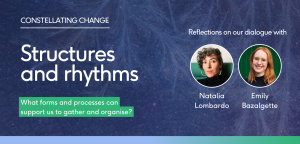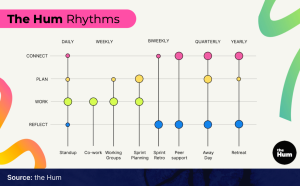This thought piece is part of a series sharing key insights from Constellating Change, our 2023/24 learning and practice series that shone a light on the dynamics and patterns of organising for systems change. It is written by Anna Birney, CEO (Chief Enabling/Evolving Officer) at the School of System Change.

Bringing Our Drumbeats to Life
“Rest is resistance”
“Nothing is set in stone”
“All change is loss work”
In this Constellating Change session, our contributors and participants drew awareness to the persistent drumbeat to which we are often working, collaborating and living. The beat of a society that was designed for factories, deadlines, and ways of working that do not fit with how we are as humans - ones who are alive, different, in different contexts and within a living world that also has seasonality. We are alive and not machines.
How might we listen to what we need - be it as a parent, a woman with monthly cycles, or if we are ill or just tired? How do we listen to the natural rhythms that might nourish us collectively? How might we then bring structure to how we come together - plan, work, play, reflect and connect? What does it mean to give ourselves internal permission to shift the way we work?
In this session we were joined by contributors Natalia Lombardo, Co-founder & Collaboration Coach at TheHum.org, and Emily Bazalgette, regenerative organisational designer, coach and chronic illness advocate - who helped us understand how we might breathe life into the structures and processes that we implement in our organisations and the ways we organise for change.
Meet Our Contributors
Accepting and Flowing
Emily shared her experience of chronic illness and how it can inform how we organise with more life-giving and regenerative forms - helping us take inspiration from the seasons and cycles around us. This made way for conversations about how we also need to consider how we stop, how we say no, and how we pay attention to endings in our work - helping us welcome it all. Emily suggested some practices to support this dance, such as documenting enough to allow others to pick things up and support communication, as well as being open to the deep trust and radical acceptance which can give us the space to ask questions like, is this deadline really a deadline?
She framed these practices under three principles, which you can read more about here:
- Take inspiration from seasons and cycles
- Adopt “continuous handover” communication
- Underpinned by trust and radical acceptance
Finding Our Natural Rhythm
Nati provided us with ways we might design with the context of being living organisms, finding pulses, heartbeats, and breathing cycles that can create the agile working whilst also making adjustments and changes as things move together.
We talked about some of the micro practices such as check-ins and retrospectives that give helpful structure to our rhythms of working, building relational trust in a working environment. This Rhythms Map diagram was shared as an example of something we could design and create together as a team, to support rhythms that work for us.

Through the discussion we continued to explore how we can give ourselves the internal permission to try out these different ways of being - to live with what is good enough, not to lock things down too soon, to evolve and move with life's ebbs and flows - to give life and spaciousness to our creativity and humanness. What might emerge is a drumbeat with a rhythm that supports our ways of living and working together.
Learning and Practice Invitations
- Review the three principles offered by Emily and consider how to bring these into your team’s way of working - suited to your unique context.
- With your team, facilitate a 30-60 minute conversation around The Hum’s Rhythms Mapping exercise, exploring your pulses of coming together to Connect, Plan, Work and Reflect.
- With your team, consider the following questions:
- How might we structure our ways of working according to need and ability?
- How might we create rituals around endings and recognise that if we are picking something else up, what is it we are letting go of?
- How might we dance with people’s ability and need in any context or moment in time?
- What rhythms might you have internalised and how do these serve you, or not serve you?
- How do we honour our capacities and cycles, and enable us to say no for now?
- How might we surrender to the reality that we are humans and we flex, flow and feel change?
- How might we move to the way we and the world actually worksrather than overly imposed management structures?
Deeper Dive Resources
- Blog: Emily Bazalgette, ‘Chronic illness-informed organising is regenerative’ (2023). Published on Medium.
- Exercise: Richard Bartlett, ‘Rhythms mapping exercise’ (2024) Published on the Hum website, shared by contributor Natalia Lombardo.
- Webpage: Chayn, ‘What it's like to work at Chayn’ (date unknown). Published on Notion, recommended by contributor Emily Bazalgette.
- Blog: Emma Proud, ‘Berkana Two Loop Model: A quick introduction to an accessible model for systems change’ (2023). Published on the LinkedIn blog.
- Blog: Hannah Thomas Uose, ‘Mission, vision, values, metaphor: What story does your organisational structure tell?’ (2021). Published on Medium.
- Paper: Karen O’Brien, Rosario Carmona, Irmelin Gram-Hanssen, Gail Hochachka, Linda Sygna, and Milda Rosenberg, ‘Fractal Approaches to Scaling Transformations to Sustainability’ (2023). Published in Ambio: a journal of environment and science.
- Book: Sam Killermann and Meg Bolger, ‘Unlocking the Magic of Facilitation: 11 Key Concepts You Didn't Know You Didn't Know’ (2016). Published by Impetus Books.

Written by Anna Birney
If you're interested in bringing this learning into your organisation or network, get in touch with Sean, our Learning and Practice Partner Lead. To keep inquiring with us as we explore more themes, subscribe to the School newsletter for systems change insights, inspiration and resources.








